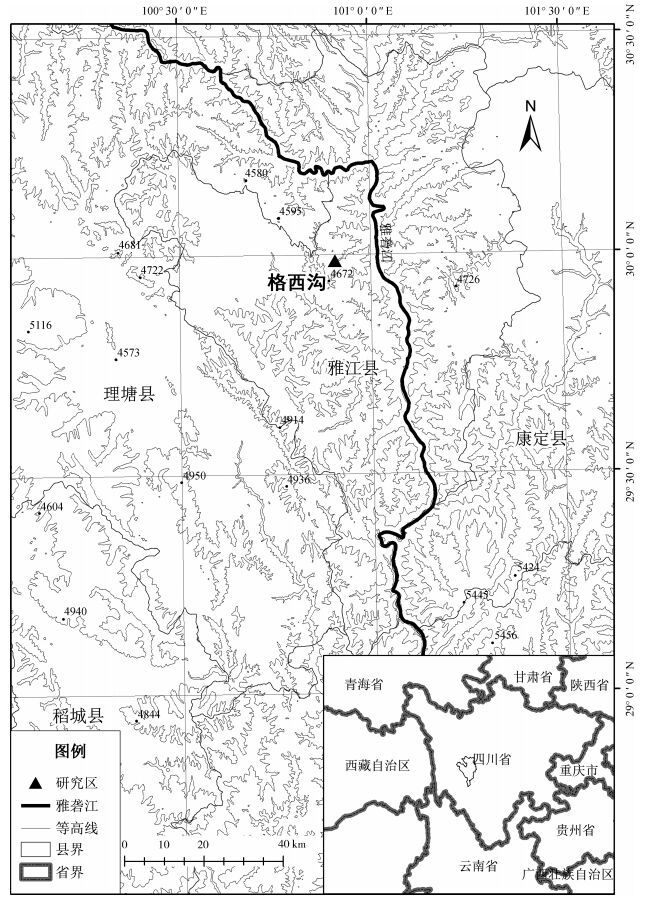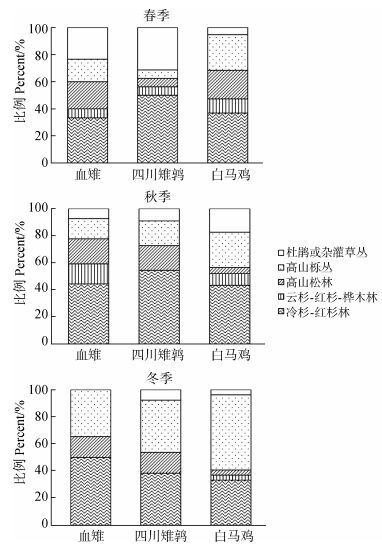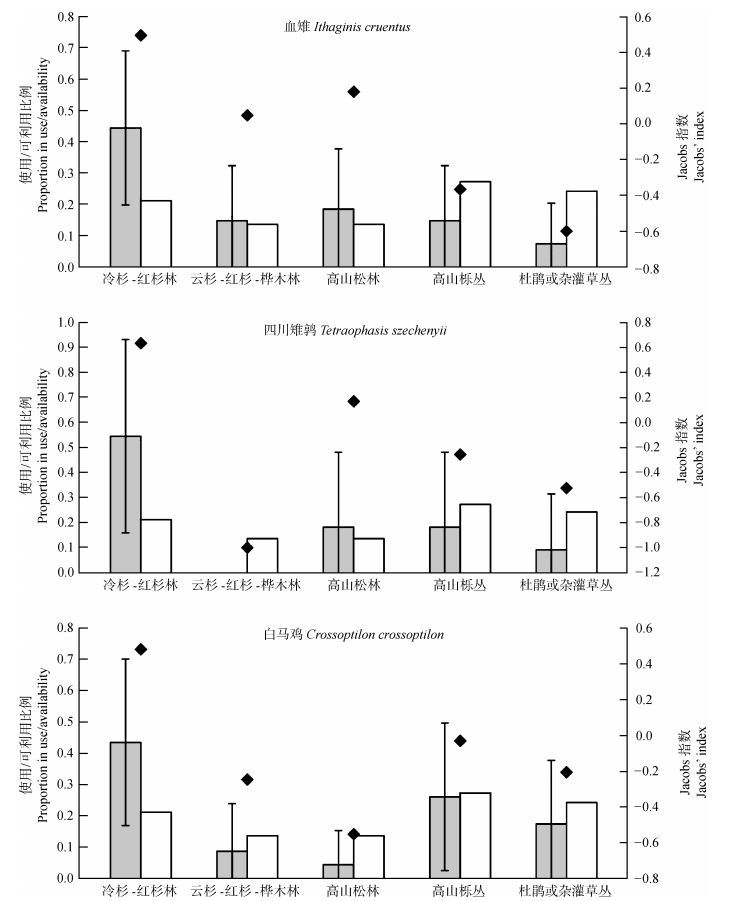扩展功能
文章信息
- 徐雨, 王彬, 窦亮, 冉江洪, 刘世荣, 岳汉秋, 杨柳, 宗建伟, 李彦娇, 李八斤
- XU Yu, WANG Bin, DOU Liang, RAN Jianghong, LIU Shirong, YUE Hanqiu, YANG Liu, ZONG Jianwei, LI Yanjiao, LI Bajin
- 三种同域高山鸡形目鸟类的生境选择
- Habitat Selection by Three Sympatric High-mountain Galliformes
- 四川动物, 2017, 36(3): 258-265
- Sichuan Journal of Zoology, 2017, 36(3): 258-265
- 10.11984/j.issn.1000-7083.20170001
-
文章历史
- 收稿日期: 2017-01-02
- 接受日期: 2017-02-22
2. 贵州师范大学生命科学学院, 贵阳 550025;
3. 四川大学生命科学学院, 成都 610064;
4. 中国林业科学研究院森林生态环境与保护研究所, 北京 100091;
5. 平顶山学院旅游与规划学院, 河南平顶山 467000;
6. 格西沟国家级自然保护区, 四川雅江 627450
2. College of Life Sciences, Guizhou Normal University, Guiyang 550025, China;
3. Collage of Life Sciences, Sichuan University, Chengdu 610064, China;
4. Institute of Forest Ecology, Environment and Protection, Chinese Academy of Forestry, Beijing 100091, China;
5. College of Tourism and Planning, Pingdingshan University, Pingdingshan, Henan Province 467000, China;
6. Gexigou National Nature Reserve, Yajiang, Sichuan Province 627450, China
鸡形目Galliformes鸟类是濒危程度较高的一个动物类群(张正旺等, 2003;McGowan et al., 2012)。当前, 由于人类活动加剧, 生境退化或破碎化问题日益严峻, 鸡形目鸟类面临的威胁也日益严重(McGowan et al., 2012)。因此, 鸡形目鸟类被视为生态环境变化的指示性物种(张正旺等, 2003;McGowan et al., 2009;Lu, 2012)。选择鸡形目鸟类开展研究, 揭示其生存现状及对环境的选择和适应, 对生物多样性保护工作十分必要。
生境是指动物出现的环境空间, 对维持动物的生存和繁衍具有重要作用(Bibby et al., 1998)。生境选择在保护生物学研究中占据重要地位(Bibby et al., 1998;Sutherland & Green, 2004)。只有了解物种的生境选择特性, 才能深入认识物种对环境的适应性, 进而预测物种的理论分布及未来气候和土地变化对物种的潜在影响(Bibby et al., 1998;Sutherland & Green, 2004)。对濒危鸡形目鸟类的生境选择已开展了广泛的研究, 但是, 当前研究以单一物种的生境选择为主。近年来, 基于生态学和保护生物学理论的发展, 一些研究者提倡关注同域多物种的生境选择问题(Jia et al., 2005;崔鹏等, 2008;Wang et al., 2008;Soldatini et al., 2010)。研究同域物种的生境选择, 不仅对于认识物种共存、竞争及生态位分化具有重要理论意义(Zhang et al., 2006), 在实践中也有助于物种的区域整合管理(Sachot et al., 2003;Soldatini et al., 2010)。
本研究选择川西高原3种典型同域珍稀濒危鸡形目鸟类, 即四川雉鹑Tetraophasis szechenyii、白马鸡Crossoptilon crossoptilon和血雉Ithaginis cruentus(四川雉鹑为国家Ⅰ级重点保护野生动物, 白马鸡和血雉为国家Ⅱ级重点保护野生动物), 开展季节性的生境选择研究。主要目的在于:(1) 检验3个物种之间的生境选择是否存在差异;(2) 检验同一物种不同季节是否存在生境选择差异。据此为物种保护与保护区管理提供决策依据。
1 研究方法 1.1 研究地区研究区位于四川省甘孜藏族自治州雅江县格西沟国家级自然保护区(图 1), 海拔3 300~4 500 m, 面积约200 km2。属青藏高原亚湿润气候。依据样点调查, 按照主要建群种, 将研究区的生境划分为5种植被群丛, 扼要描述如下:

|
| 图 1 研究区位置示意图 Fig. 1 Map of the study site |
| |
(1) 冷杉-红杉林:优势树种为鳞皮冷杉Abies squamata和大果红杉Larix potaninii var. macrocarpa。乔木盖度5%~75%, 灌木盖度5%~60%。
(2) 云杉-红杉-桦木林:优势树种为大果红杉、桦木Betula spp.、川西云杉Picea likiangensis var. balfouriana等。乔木盖度5%~65%, 灌木盖度10%~75%。
(3) 高山松林:高山松Pinus densata为绝对优势种。乔木盖度10%~80%, 灌木盖度0%~70%。
(4) 高山栎丛:川滇高山栎Quercus aquifolioides为绝对优势种。乔木盖度0%~80%, 灌木盖度5%~80%。
(5) 杜鹃或杂灌草丛:包含多种杜鹃Rhododendron spp., 其他常见灌木有柳Salix spp.、金露梅Dasiphora spp.。草本包括早熟禾Poa spp.、青茅Deyeuxia spp.、蒿草Kobresia spp.、委陵菜Potentilla spp.、蓼Polygonum spp.、风毛菊Sausurea spp.等。灌木盖度可达90%, 草本盖度可达100%。
1.2 野外调研在2014年4月—2015年1月, 分春、秋、冬3个季节采用样带法开展野外调研。沿不同山脉走向共设置17条样带(样带长1~6 km), 兼顾海拔和植被类型变化。每个季节开展1次调查, 调查主要在09: 00—17: 00进行。研究者(2~3人组成)以约1.5 km·h-1的速度沿样带行进, 一旦在两侧一定范围内(<20 m)看见雉类实体或听见鸣叫, 或者发现其他可以分辨和证明物种使用生境的信息(如新鲜的尾羽或飞羽、粪便), 记录其所在生境类型。为了避免重复取样, 在每次调查中将羽毛和粪便等痕迹移出。
此外, 为了量化研究区不同生境类型的可利用性状况(Johnson, 1980), 在样带调查中, 海拔每升高100 m, 设置1个对照, 记录其生境类型。因天气等特殊情况限制, 不同季节部分样带的实际取样长度有所差异, 因此表现为不同季节的对照数不一致, 不同生境的可利用率有所差异。
1.3 统计方法采用Jacobs指数法(Jacobs, 1974)分析物种对生境的选择性。计算公式如下:

|
公式中, Di表示物种对生境i的选择指数, ri为生境i的使用率(即对生境i的使用数占样本总数的比例), pi为生境i的可利用率(在系统取样中, 对该生境类型的取样数占对照样本总数的比例)。Di的取值区间为[-1, 1]:当Di>0, 表示喜好;当Di<0, 表示拒绝。
进一步使用Bonferroni修正检验分析物种是否显著偏好或拒绝某一生境(Manly et al., 2002)。对于某一生境, 若其使用率95%置信区间的低值高于其可利用率, 表示被显著喜好;相反, 95%置信区间的高值低于其可利用率, 表示被显著拒绝。若95%置信区间与可利用率存在重叠区, 表示不显著。分析在R 3.2.0(R Development Core Team, 2015)上完成。
2 结果春季发现了3个物种65处生境使用点, 秋季发现61处, 冬季发现66处(表 1)。春季对照49处, 秋季对照66处, 冬季对照46处。不同物种对生境的利用格局存在一定差异(图 2)。
| 物种 Species | 监测数Number (%) | ||
| 春季 Spring | 秋季 Autumn | 冬季 Winter | |
| 血雉Ithaginis cruentus | 30(46.2) | 27(44.3) | 26(39.4) |
| 四川雉鹑Tetraophasis szechenyii | 16(24.6) | 11(18.0) | 13(19.7) |
| 白马鸡Crossoptilon crossoptilon | 19(29.2) | 23(37.7) | 27(40.9) |

|
| 图 2 3种鸡形目鸟类的生境利用格局比较 Fig. 2 Comparison of habitats use patterns by 3 different galliform species |
| |
春季, 四川雉鹑对冷杉-红杉林的Di>0, 且使用率95%置信区间的低值高于该生境的pi, 揭示四川雉鹑显著喜好冷杉-红杉林;相反, 对高山栎丛的Di<0, 而使用率95%置信区间的高值低于该生境的pi, 揭示其显著拒绝高山栎丛(图 3:B)。同理, 白马鸡显著拒绝杜鹃或杂灌草丛(图 3:C)。对血雉而言, 各生境使用率95%置信区间与pi均存在重叠, 表示对各生境的喜好或拒绝并不显著(图 3:A)。

|
| 图 3 春季不同生境的使用率(95%置信区间, 灰色柱)与可利用率(白色柱)及Jacobs指数(黑色点) Fig. 3 Proportion of habitat types (95% confidence interval; gray bars) used by different galliform species and the availability (white bars) and Jacobs' index values (black diamonds) in spring Jacobs指数>0表示喜好, <0表示拒绝;若95%置信区间没有与可利用率重叠, 表示偏好或拒绝达到显著程度;下同。 Jacobs' index values indicate preference ( > 0) and avoidance ( < 0), but preference or avoidance was interpreted as being statistically significant for a particular habitat type if the confidence interval for use did not overlap with the availability; the same below. |
| |
同理, 秋季, 血雉显著拒绝杜鹃或杂灌草丛(图 4:A), 四川雉鹑和白马鸡对各生境的喜好或拒绝的差异无统计学意义(图 4:B, C)。冬季, 所有物种均显著拒绝杜鹃或杂灌草丛(图 5);此外, 白马鸡还显著偏好高山栎丛(图 5:C)。

|
| 图 4 秋季不同生境的使用率(95%置信区间, 灰色柱)与可利用率(白色柱)及Jacobs指数(黑色点) Fig. 4 Proportion of habitat types (95% confidence interval; gray bars) used by different galliform species and the availability (white bars) and Jacobs' index values (black diamonds) in autumn |
| |

|
| 图 5 冬季不同生境的使用率(95%置信区间, 灰色柱)与可利用率(白色柱)及Jacobs指数(黑色点) Fig. 5 Proportion of habitat types (95% confidence interval; gray bars) used by different galliform species and the availability (white bars) and Jacobs' index values (black diamonds) in winter |
| |
研究同域物种的生境选择, 对于认识物种共存、竞争及生态位分化具有重要理论意义, 对于物种的区域整合保护与管理也有实践价值(Sachot et al., 2003;Zhang et al., 2006;Soldatini et al., 2010)。本研究对川西高原3种同域分布的濒危鸡形目鸟类, 即四川雉鹑、白马鸡和血雉的生境选择进行研究。结果揭示, 不同物种的生境选择具有差异, 同一物种不同季节的生境选择也具有差异。
早前一些研究者分别对上述3个物种开展过生境研究(贾陈喜等, 2004;贾非等, 2004;Xu et al., 2010;徐雨等, 2014)。Jia等(2005)对同域分布的血雉和白马鸡的生境选择进行过比较。这些研究大多是对生境结构进行比较, 未分析物种对植被类型的选择。Xu等(2016b)分析了四川雉鹑不同季节对植被类型的选择, 本研究结果与之相同之处在于均揭示四川雉鹑春季喜好冷杉-红杉林;而不同的是, Xu等(2016b)指出四川雉鹑不同季节皆拒绝高山松林, 而本研究指出其不同季节拒绝的植被类型不同, 如春季拒绝高山栎丛, 冬季拒绝杜鹃或杂灌草丛。另外, Xu等(2016b)指出四川雉鹑秋季与冬季偏好高山栎丛, 而本研究发现其在秋季与冬季并未对任何植被有显著偏好。对此, 推测物种生境选择与不同研究区的植被组成和异质性相关, 某一地区不同植被的相对多度与组成或镶嵌格局可能会影响物种对不同植被的选择(Lorenzón et al., 2016)。因此, 建议从更大尺度(如家域尺度)深入研究雉类对植被类型的选择, 以及异质性对选择的影响。
同一物种不同季节的生境选择存在差异, 表明生境选择具有时间变化(Mayor et al., 2009)。变化可能与季节导致的环境变化有关, 比如食物资源、温度变化(Dupke et al., 2016)。冬季, 3个物种皆拒绝杜鹃或杂灌草丛, 可能是该生境分布在较高海拔, 冬季温度较低, 在厚重的雪盖下, 既不利于物种保存热量, 又不利于觅食。冬季, 白马鸡明显偏好高山栎丛。高山栎丛一般位于南坡, 上层盖度较大, 利于物种保持体温;再者, 下层灌木呈丛状, 地被上残留的坚果丰富, 便于体型较大的白马鸡获取食物。
不同物种的生境选择具有差异, 表明存在一定程度的生态位分化。生态位的分化主要与种间的资源竞争有关(Hardin, 1960;Alley, 1982), 对环境中有限资源的竞争驱动物种采取不同的觅食策略。但是, 对此可能需要进一步明确物种的食性差异才能给予说明。生境选择的种间差异也可能是由于物种自身不同的生活史特征导致了不同的能量保存和天敌防护策略。比如, 在本次调查的春季与秋季, 天气并不十分寒冷, 但是杜鹃或杂灌草丛的植物或未萌发, 或枝叶已凋落, 颜色暗淡或偏棕黄色, 血雉和白马鸡拒绝杜鹃或杂灌草丛, 可能与其艳丽或明亮的羽色有关。在此期间拒绝杜鹃或杂灌草丛, 一定程度上可减少天敌的发现与捕食;相反, 四川雉鹑羽色与此时的杜鹃或杂灌草丛颜色相近, 因此没有拒绝该生境。
Zhang等(2011)与Xu等(2016a, 2016b)建议在四川雉鹑保护管理中应该维持多样式、镶嵌式的植被群落。本研究发现3种雉类皆利用5种典型植被, 但其选择程度不同、不同季节选择不同, 进一步强调在保护管理中应维持多样式、镶嵌式的植被群落格局。我国自1998年实行天然林保护工程以来, 禁止乱砍滥伐, 对天然林的保护卓有成效。但是, 人工造林工程往往只选取某一树种(如高山松;Xu et al., 2010), 忽略了植被群落的多样性和镶嵌格局, 并不利于鸡形目鸟类的保护。因此, 建议在造林工作中增加对其他树种的选育, 比如, 近两年格西沟国家级自然保护区正在积极尝试培育杜鹃品种。在西部偏远高山地区, 迫于薪材利用, 存在诸如砍伐高山栎丛的情形(Wang et al., 2012;Xu et al., 2016a, 2016b)。倘若在当前经济和文化水平条件下, 不能绝对限制社区居民的砍伐, 建议在保护管理中合理限制砍伐的时间和范围。
致谢: 感谢所有参与野外数据收集工作的人员。| 崔鹏, 康明江, 邓文洪. 2008. 繁殖季节同域分布的红腹角雉和血雉的觅食生境选择[J]. 生物多样性, 16(2): 143–149. |
| 贾陈喜, 郑光美, 周小平, 等. 2004. 血雉繁殖期活动区与栖息地特征[J]. 四川动物, 23(4): 349–352. |
| 贾非, 王楠, 郑光美. 2004. 白马鸡冬季群体栖息地选择的经验模型[J]. 北京师范大学学报(自然科学版), 40(4): 524–530. |
| 徐雨, 王彬, 窦亮, 等. 2014. 四川雉鹑育雏早期雌体与幼体夜栖地的选择[J]. 四川动物, 33(5): 641–645. |
| 张正旺, 丁长青, 丁平, 等. 2003. 中国鸡形目鸟类的现状和保护对策[J]. 生物多样性, 11(5): 414–421. |
| Alley TR. 1982. Competition theory, evolution, and the concept of an ecological niche[J]. Acta Biotheoretica, 31(3): 165–179. DOI:10.1007/BF01857239 |
| Bibby C, Marsden S, Fielding A. 1998. Bird-habitat studies[M]//Bibby CJ, Jones MJ, Marsden SJ. Expedition field techniques:bird surveys. London:Expedition Advisory Centre, Royal Geographical Society. |
| Dupke C, Bonenfant C, Reineking B, et al. 2016. Habitat selection by a large herbivore at multiple spatial and temporal scales is primarily governed by food resources[J/OL]. (2016-10-17)[2016-12-20].http://www.ecography.org/article/habitat-selection-large-herbivore-multiple-spatial-and-temporal-scales-primarily-governed. DOI:10.1111/ecog.02152. |
| Hardin G. 1960. The competitive exclusion principle[J]. Science, 131(3409): 1292–1297. DOI:10.1126/science.131.3409.1292 |
| Jacobs J. 1974. Quantitative measurement of food selection[J]. Oecologia, 14(4): 413–417. DOI:10.1007/BF00384581 |
| Jia F, Wang N, Zheng GM. 2005. Winter habitat requirements of white eared-pheasant Crossoptilon crossoptilon and blood pheasant Ithaginis cruentus in south-west China[J]. Bird Conservation International, 15(3): 303–312. DOI:10.1017/S095927090500047X |
| Johnson DH. 1980. The comparison of usage and availability measurements for evaluating resource preference[J]. Ecology, 61(1): 65–71. DOI:10.2307/1937156 |
| Lorenzón RE, Beltzer AH, Olguin PF, et al. 2016. Habitat heterogeneity drives bird species richness, nestedness and habitat selection by individual species in fluvial wetlands of the Paraná River, Argentina[J]. Austral Ecology, 41(7): 829–841. DOI:10.1111/aec.12375 |
| Lu X. 2012. Summer-autumn habitat use by Galliformes in a primary forest, southeastern Tibet[J]. Chinese Birds, 3(2): 113–117. DOI:10.5122/cbirds.2012.0014 |
| Manly BFJ, McDonald LL, Thomas DL, et al. 2002. Resource selection by animals-statistical design and analysis for field studies[M]. Berlin, Germany: Springer Netherlands. |
| Mayor SJ, Schneider DC, Schaefer JA, et al. 2009. Habitat selection at multiple scales[J]. Ecoscience, 16(2): 238–247. DOI:10.2980/16-2-3238 |
| McGowan PJK, Owens LL, Grainger MJ. 2012. Galliformes science and species extinctions:what we know and what we need to know[J]. Animal Biodiversity and Conservation, 35(2): 321–331. |
| McGowan PJK, Zhang YY, Zhang ZW. 2009. Galliformes-barometers of the state of applied ecology[J]. Journal of Applied Ecology, 46(3): 524–526. DOI:10.1111/jpe.2009.46.issue-3 |
| R Development Core Team. 2015. R:a language and environment for statistical computing[M]. Vienna, Austria: R Foundation for Statistical Computing. |
| Sachot S, Perrin N, Neet C. 2003. Winter habitat selection by two sympatric forest grouse in western Switzerland:implications for conservation[J]. Biological Conservation, 112(2): 373–382. |
| Soldatini C, Albores-barajas YV, Pellizzi B. 2010. Habitat preferences of high-altitude Galliformes in Sagarmatha National Park, Nepal[J]. Italian Journal of Zoology, 77(3): 347–353. DOI:10.1080/11250000903337909 |
| Sutherland WJ, Green RE. 2004. Habitat assessment[M]//Sutherland WJ, Newton I, Green RE. Bird ecology and conservation:a handbook of techniques[Techniques in ecology and conservation series]. New York:Oxford University Press. |
| Wang N, Zheng G, McGowan PJK. 2012. Pheasants in sacred and other forests in western Sichuan:their cultural conservation[J]. Chinese Birds, 3(1): 33–46. DOI:10.5122/cbirds.2012.0003 |
| Wang W, Ren G, He Y, et al. 2008. Habitat degradation and conservation status assessment of gallinaceous birds in the Trans-Himalayas, China[J]. Journal of Wildlife Management, 72(6): 1335–1341. DOI:10.2193/2007-077 |
| Xu Y, Wang B, Dou L, et al. 2016a. Estimating density of a rare and cryptic high-mountain galliform species, the buff-throated partridge Tetraophasis szechenyii[J]. Avian Conservation and Ecology, 11(1): 10. DOI:10.5751/ACE-00853-110110 |
| Xu Y, Yang N, Wang B, et al. 2016b. Seasonal habitat use of a rare high-mountain galliform species, the buff-throated partridge (Tetraophasis szechenyii)[J]. North-Western Journal of Zoology, 12(2): 314–318. |
| Xu Y, Yang N, Wang Y, et al. 2010. Roosting behavior and roost selection by buff-throated partridges Tetraophasis szechenyii during the breeding season[J]. Zoological Studies, 49(4): 461–469. |
| Zhang K, Yang N, Xu Y, et al. 2011. Nesting behavior of Szechenyi's monal partridge in treeline habitats, Pamuling Mountains, China[J]. Wilson Journal of Ornithology, 123(1): 93–96. DOI:10.1676/10-035.1 |
| Zhang Z, Wei F, Li M, et al. 2006. Winter microhabitat separation between giant and red pandas in Bashania faberi bamboo forest in Fengtongzhai Nature Reserve[J]. Journal of Wildlife Management, 70(1): 231–235. DOI:10.2193/0022-541X(2006)70[231:WMSBGA]2.0.CO;2 |
 2017, Vol. 36
2017, Vol. 36




